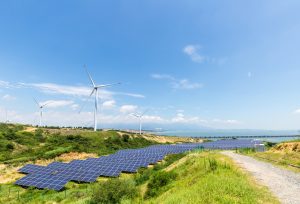In the wake of COP28, the global commitment to tripling renewable energy capacity resonates as a cornerstone in the journey toward a sustainable future. China and Europe, both giants in the renewable energy landscape, are following distinct paths on energy and climate policy, but face similar challenges and embrace common aspirations.
At this year’s COP28, led by the G-20, countries committed to tripling renewable energy capacity, a step recommended by the International Renewable Energy Agency, which noted this goal would be necessary to get the world back on track toward meeting the Paris Climate Agreement targets. The Sunnylands Statement between the United States and China, issued by their climate envoys in mid-November in the lead-up to COP28, also pledges these two countries to accelerate their own deployment of renewables.
While China leads in renewable energy capacity globally, would China be capable of tripling its renewable capacity by 2030? Based on tripling capacity from a 2020 level, as mentioned in the Sunnylands Statement, China would need to reach roughly 2,700 GW of renewables by 2030, or roughly 2,000 GW of wind and solar. The addition of 200-230 GW of wind and solar this year indicates this target would be well within reach.
In contrast, Europe seems unlikely to triple its own renewable energy capacity, which stood at 750 GW at the end of 2022. The continent would have to more than triple the present rate of installations to reach that goal. Various countries are working to streamline regulations and speed construction of renewables. Despite falling costs for wind and solar equipment, higher interest rates pose challenges to project costs.
Assuming wind and solar simply continue growing at their present pace, China would obtain well over 30 percent of its electricity from wind and solar by 2030. That is a level where renewables begin to have a significant impact on system planning and reliability.
Given that renewable capacity is still rising exponentially, higher ambition is possible. Several international and Chinese analysts anticipate that China could reach peak emissions before 2025. Last year, Berkeley scholars modelled how China could achieve a 80 percent carbon-free electricity system by 2035, years ahead of when China’s own planners expect to achieve such an ambitious goal. The model shows that the most important enabling factors are greater flexibility for inter-provincial transmission, combined with a small amount of energy storage and demand response.
Amid this transitional phase, a shared challenge remains: the need to phase out reliance on coal. China grapples with the complexity of integrating its surging renewable output, yet is simultaneously greenlighting new coal projects. In contrast, European countries are rapidly developing policies and experiences dealing with a high share of renewable energy, and are in the process of accelerating the phase-out of coal energy.
The circumstances in Europe and China aren’t always as different as they often seem. While Chinese experts typically note the challenge of integrating renewable energy given its seasonal variability and geographic location, in Europe the seasonality and geographic differences are even more pronounced than in China. For example, during Germany’s winter, solar produces just a third of the output available in summer months. In China, most regions see winter solar output reach at least 60-70 percent of summer output.
The geographic disparities of wind and in Europe mean transitioning to renewable energy requires greater flexibility and breaking down physical and market barriers to power trading between regions – all important lessons China will need to benefit from.
Europe and China share a paramount focus on energy security. Both regions are highly dependent on energy imports, prompting the development of policies addressing energy security concerns without compromising global climate commitments. Europe’s transition to clean energy demonstrates a direct link to enhanced energy security – each unit of wind and solar electricity generated over the past two years translates to reduced reliance on imported energy. The stability of renewable-based electricity prices contrasts with the erratic fluctuations in fossil fuel prices, and underscores the resilience that renewables can contribute in times of crisis.
Renewables are domestically produced and inherently less susceptible to global conflicts compared to fossil fuels. Despite concerns regarding dependence on Chinese clean energy supply chains, the resilience of already installed renewables ensures consistent electricity generation, irrespective of external circumstances.
It is already obvious that Europe cannot fight climate change without China. In scaling up its own clean energy innovation and manufacturing, Europe also needs to work with China.
China, even as it leads in renewable capacity and manufacturing, looks to Europe’s expertise in renewable integration. Europe’s response to the Ukrainian crisis, despite criticisms of its energy markets, demonstrated the strength of its energy transition. Looking forward, Germany’s grid has recently reaffirmed its forecast reliability through 2030 despite transitioning from nuclear and fossil-fired power.
Ultimately, the synergies between China’s rapidly growing clean energy sector and Europe’s market and policy experience must work together for the global energy transition to succeed. While it is all too easy to focus on the differences, current trends indicate a convergence of trajectories, common challenges, and unified objectives. Working together can only accelerate progress toward a sustainable, resilient, and clean energy transformation.

































